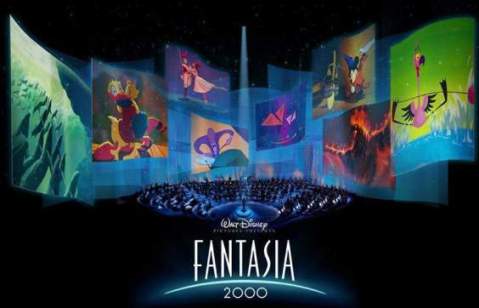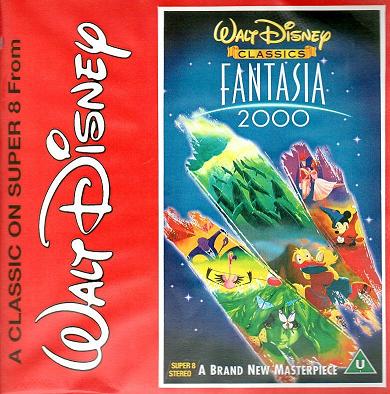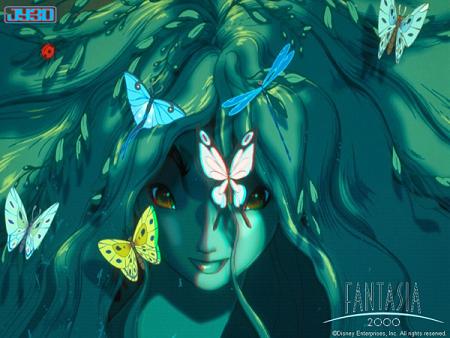|
Author
|
Topic: Fantasia 2000
|
Gian Luca Mario Loncrini
Phenomenal Film Handler

Posts: 1948
From: Verona (Italy)
Registered: Jan 2009
|
 posted October 25, 2009 10:59 AM
posted October 25, 2009 10:59 AM





FANTASIA 2000
USA, 1999
Running time: 75 min.
Derann Release

- Ludwig van Beethoven's 'Symphony No. 5 in C minor-I. Allegro con brio' – abstract patterns resembling butterflies and bats explore a world of light and darkness which are conquered by light at last (directed by Pixote Hunt).
- Ottorino Respighi's 'Pines of Rome' – this segment features a family of frolicking humpback whales that are able to fly due to a supernova. At one point, the whale calf is separated from his parents when he's trapped in an iceberg, later finding his way out with his mother's help. The final section, the Via Appia gives the impression of the larger pod of adults in migration (directed by Hendel Butoy).
- George Gershwin's 'Rhapsody in Blue' – an episode of 1930s-era New York City, depicting the day in the lives of several people within the Depression-era bustling metropolis, as scenes drawn in the style of Al Hirschfeld's famous cartoons of the era, including an animated cameo of Gershwin the composer himself at the piano. The little girl in the hotel is based on the Eloise character created by Kay Thompson and the red-haired man is based on John Culhane, the author for the "making of" books for both Fantasia and Fantasia 2000 (directed by Eric Goldberg).
- Dmitri Shostakovich's 'Piano Concerto No. 2 in F Major-I. Allegro' – based on Hans Christian Andersen's The Steadfast Tin Soldier. The setting is appropriate - the concerto was written as a gift by Shostakovich to his musically gifted young son, and the percussive rhythms also suit a story about a soldier. However, the ending is a happy one in contrast with that of the original story (directed by Hendel Butoy).
- Camille Saint-Saëns's 'The Carnival of the Animals, Finale' – A flock of flamingos try to force a slapstick member who enjoys playing with a yo-yo to engage in their "dull" routines, designed to delight children with the on-screen hysterics; music arranged by Peter Schickele. A number of real yo-yo tricks, including "Walk the Dog", "Rock the Cradle", and "UFO", are featured (directed by Eric Goldberg).
- Paul Dukas's 'The Sorcerer's Apprentice' – a segment from the original Fantasia featuring Mickey Mouse. Mickey brings a broom to life with the magical hat left by his master to carry water to a cauldron, but is in danger when he can't stop the broom (directed by James Algar).
- Edward Elgar's 'Pomp and Circumstance - Marches 1, 2, 3 and 4' – is a pastiche of the story of Noah's Ark, with Donald Duck as first mate to Noah. Donald musters the animals to the Ark, and misses, loses, and is reunited with Daisy Duck in the process; music arranged by Peter Schickele, including a wordless soprano solo by Kathleen Battle as part of the No. 1 March ('Land of Hope and Glory'). Directed by Francis Glebas.
- Igor Stravinsky's 'Firebird Suite' - 1919 Version – the story of a spring Sprite and her companion Elk. After a long winter she restores the life to the forest but accidentally awakes the fiery spirit of destruction (the namesake Firebird of the piece) in a nearby volcano. The Firebird proceeds in destroying the forest and seemingly the sprite. She is restored to life however after the destruction and the forest life is reborn with her after some encouraging from the Elk. The story is considered an exercise in the theme of life-death-rebirth deities. The animation is based on the May 18th, 1980 eruption of Mt. St. Helens. The final tableau is a near analogue of the view of the volcano's crater from "Windy Ridge" (directed by Gaëtan and Paul Brizzi).
The plan for the original Fantasia movie was for it to be a kind of permanently running show, periodically adding new episodes while others would be rotated out. However, the film's failure to achieve success at the box office, combined with the loss of the European market due to World War II, meant that the plan went unused. Accordingly, Fantasia 2000 implemented this idea by retaining the sequence with Mickey Mouse as the Sorcerer's Apprentice, arguably the most popular segment from the original film.
Composer André Previn reports in his book No Minor Chords that he was approached by Disney to work on as a sequel to Fantasia. He declined the project when he learned that the soundtrack was, at that point, conceived of as an orchestration of Beatles songs.
Development for Fantasia 2000 began in 1990, and production began the following year. The music selections were made as a collective decision by Roy E. Disney, James Levine, and members of the production staff. Most were decisions driven by the musical preferences of the team; Roy personally chose the Pines of Rome. Other pieces were discovered long after the story ideas were set, such as the Steadfast Tin Soldier, where the visuals were based on artwork done for the original Fantasia, but the Shostakovich piece was presented to the team by an animator relatively late into the production schedule.
Fantasia 2000 was originally scheduled for a release in the mid 1990s with the name Fantasia Continued; it was later renamed Fantasia 1999 until the release date was moved into 2000. In order to tie Fantasia 2000 to the original idea of a rotating program, three sections from the original Fantasia were intended to remain in Fantasia 2000. However, only 'The Sorcerer's Apprentice' made it into the final release. The late addition of 'Rhapsody in Blue' replaced 'Dance of the Hours' a year before release, and the 'Nutcracker Suite' was a part of Fantasia 2000 until a few months before it reached theaters. After several test screenings and after much of the publicity material had already been produced, the 'Nutcracker Suite' was removed to shorten the running time of the movie.
'Rhapsody in Blue' was a work already in progress by director Eric Goldberg (lead animator for the Genie in Aladdin, also inspired by Al Hirschfeld's art), when Disney approached him to complete the piece for the movie. This decision was ideal given the head start on the work and so that the film could include a work from an American composer. Taking on 'Rhapsody in Blue' also allowed Disney to keep the animators assigned to their feature Kingdom of the Sun (later released as The Emperor's New Groove) busy while Kingdom went through an extensive rewrite. Some press articles written after the completion of Groove reversed the roles, saying that Goldberg first approached Disney for Rhapsody for Fantasia 2000 and was initially rejected, and later the producers came back to him as a result of the need find something to do with the animation staff while the Kingdom rewrite was going on.
One significant difference in the musical styles between the films is that in Fantasia 2000 the piano features prominently in more than half of the selections, while the original Fantasia did not have a piano in any segment.
Fantasia 2000 features many technical innovations that would later be utilized in the Disney studio's other animation works, particularly in the use of computers. Both 'Pines of Rome' and 'The Steadfast Tin Soldier' were primarily CGI pieces, completed before Pixar's landmark film Toy Story was released. The horns on the elk in The Firebird were CGI-rendered on top of hand-drawn animation (giving them a higher consistency, when compared to 'Bambi' which was all drawn by hand), a technique that would be used in 'Treasure Planet' for the character Silver.
The producers felt that some break between the musical segments was necessary to "cleanse the palate", so a series of "interstitials" were directed by Disney animation producer Don Hahn. Instead of using a single narrator as in Fantasia, the individual pieces are introduced by people from different areas of the art world. After the film opens with Beethoven's Fifth, Steve Martin discusses the history of Fantasia being a continuing concept and is immediately followed by Itzhak Perlman, who introduces 'Pines of Rome'. Quincy Jones leads into the Gershwin number, and Bette Midler gives an introduction to the Shostakovich concerto, both featuring on screen the piano players for the respective pieces. James Earl Jones introduces 'Carnival of the Animals' with director Eric Goldberg, and, appropriately enough, magicians Penn and Teller make an appearance before 'The Sorcerer's Apprentice'. When this piece concludes with Mickey Mouse's conversation with conductor Leopold Stokowski from the original Fantasia, Mickey then moves on to chat with Levine before the latter introduces 'Pomp and Circumstance'. The final sequence of The Firebird is introduced by Angela Lansbury.
(from Wikipedia)
The 8mm Derann release is supplied on 4*600ft spools. It is the complete letterboxed theatrical edition with STEREO sound.
A little bluish, but very good color and definitely a stunning print. A 'must' for all of Disneys collectors.
Unfortunately, this was the last full Disney animated feature released by Derann, but thanks God it is still available. Separate segments are available too.
Some shots from my print were already posted on the WHAT FILM DID YOU SHOW LAST NIGHT section. More will be soon posted here.
--------------------
I remember when I was (super) 8 years old...
| IP: Logged
|
|
|
|
|
|
|
|
|
|
|
|
|
|
Osi Osgood
Film God

Posts: 10204
From: Mountian Home, ID.
Registered: Jul 2005
|
 posted November 07, 2009 10:05 AM
posted November 07, 2009 10:05 AM




Gian, just curious. Is the "Scorceror's Apprentice" segment in letterbox like the rest of the feature, or is it in the original full frame (flat) of it's original prrsentation?
I have the classic Era Disney 200ft 9 minute segment, which I just add to the rest of the Fantasia 2000 feature, as the copy that I bought didn't have MIckey's segment.
I note that in your screen captures, that your print has that bluish cast as well. While it is passable, I think it works better when it is a live action film. Color is so important when it comes an animated film.
Still, I was so surprised when this ended up being released on Super 8 by Derann. After all, it is a year 2000 movie. I wonder if this was perhaps among the last Disney/Derann official releases?
UPDATE! I read the last part of the review. Yes, it was the last Disney Derann feature release.
There was only one thing I didn't like about this fantasia 2000.
The original did only have one person who introdued each segment and I felt that this worked quite well. I think it was a mistake to have assorted different people introduce the film.
. I'm sure that they could have come up with someone who would have been perfect to introduce all the segments.
--------------------
"All these moments will be lost in time, just like ... tears, in the rain. "
| IP: Logged
|
|
|
|
|
|
|
|
|
|
|
|
|
|
|
|
|
|
|
|
|
|
|
|
|
|
Bill Brandenstein
Phenomenal Film Handler
Posts: 1632
From: California
Registered: Aug 2007
|
 posted August 21, 2012 11:15 PM
posted August 21, 2012 11:15 PM



Having just shown a worn but enjoyable copy of this I got early this year from The Reel Image with DVD sound, I have some information here that might be useful to anyone needing technical details on Fantasia 2000. I had to carefully account for the timings and lengths of each of the original reels (even though my copy came all spliced together on an extend-a-reel) to make that audio work.
The Fantasia 2000 print is absolutely complete at 74 1/2 minutes and came on 4 reels, not 3, which appear to correspond precisely to the reel configuration of the 35mm theatrical release prints. Reel 2 is unusually long for a single reel, but due to the thinner polyester stock would've still fit comfortably on a 15" theater reel or a 7" Super 8 reel. Still, this Super 8 print apparently came from Derann on 8" 600' reels anyway.
This is a "masked" flat print, which is to say, "letterboxed." The masking is decently steady and perfectly consistent from reel to reel, so it's quite reasonable to shorten the height of your screen or use a wider screen and "zoom out" to fill the width. "Sorcerer's Apprentice" is printed relative to that masking, so none of the original image is cut off. However, on this Super 8 print, by combining the widescreen mask with the narrower image, you end up with black on all 4 sides of the picture in this segment, making this print of "Apprentice" a bad choice for a standalone cutout. You'd be better off with the Super 8 prints made from the 1940 original printed full frame if you need that segment by itself.
The image quality on this print is wonderfully sharp, and other than the aforementioned blueishness, most noticable on the host segments with questionable skin tones, has lovely color.
While the sound on my print is booming loud and true stereo, the timing between the two channels is quite inaccurate and varies from reel to reel, making surround playback from the projector "unstable." Most noticably, the speaking of the hosts tended to come from the rear speakers instead of the center. At first I thought one channel was out of phase with the other, but after recording the track into the computer, I could see that one channel would be ahead of the other by a good many milliseconds. So unfortunately the sound recording could be better.
For the musical purists in the crowd, please note that all of these pieces, excepting "Sorcerer's Apprentice," were musically abridged and/or edited by the Disney gurus.
Here is a rundown of the contents of each reel.
REEL ONE (15:48)
--intro montage (homage to the 1940 Fantasia)
--Beethoven Symphony 5 (1st movement)
--hosts Steve Martin and Itzak Perlman
--Respighi "Pines of Rome" (whales)
REEL TWO (22:15)
--host Quincy Jones (& jazz pianist)
--Gershwin "Rhapsody in Blue" (set in New York City)
--hostess Bette Midler
--Shostakovich Piano Concerto #2 (soldier & ballerina)
REEL THREE (21:03)
--host James Earl Jones (& animator)
--Saint-Saens "Carnival of the Animals"
--hosts Penn & Teller
--Dukas' "Sorcerer's Apprentice" (Mickey Mouse, 1940)
--James Levine, conductor (and Mickey and Donald chasing around the room in surround sound)
--Elgar "Pomp and Circumstance" marches (Donald and the Ark)
REEL FOUR (15:24)
--hostess Angela Lansbury
--Stravinsky "The Firebird" suite (1919)
--end credits for a whopping 5 1/2 minutes!!!
Also, the trailer for Fantasia 2000 was also printed up and has even better color than the feature (don't you hate it when that happens) and similar excellent sharpness. It has a tiny bit of masking - I'm guessing for a 1.66 ratio - and is the Imax presentation trailer for the 1.1.2000 release.
| IP: Logged
|
|
|
|
|
|
|
|
|
|
|



 UBBFriend: Email this page to someone!
UBBFriend: Email this page to someone!
 Printer-friendly view of this topic
Printer-friendly view of this topic








![[Big Grin]](biggrin.gif)


![[Wink]](wink.gif)
![[Smile]](smile.gif)






